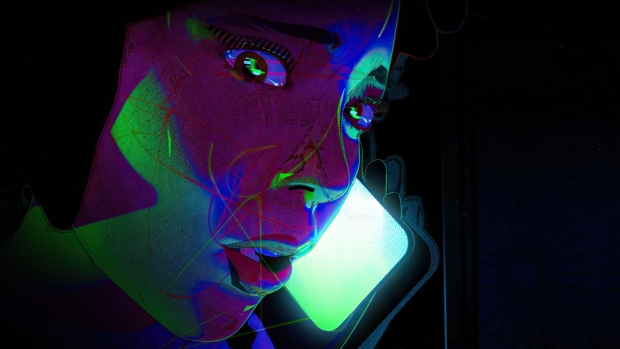Powerful 2D and 3D images meld with musician adiiilya’s vocals to delve into themes of jealousy, obsession, and toxic masculinity while portraying the characters’ fragmented minds and distorted perceptions of reality.
Writer-director-animator Nikita Kibirev shared with AWN his new animated music video, NOIR, created for musician adiiilya, along with two “behind-the-scenes” videos. The film harnesses powerful, dark, and chaotic 2D and 3D imagery to explore themes of jealousy, obsession, toxic masculinity, and the tension of a codependent relationship while delving into the fragmented mind and distorted reality of its characters.
"A bitter cocktail of jealousy, persecution, and painful love tastes like a sip of this story,” noted adiiilya. “Every time I see news about cases of the powerful inflicting violence upon the vulnerable, my blood boils with anger, freezing in my veins. I wanted to convey the suffocating tension, the fanatical obsession that scratches from within, and the mind-spinning effects of jealousy."
The video tells the story of a recently separated woman whose night of partying takes a sinister turn when she becomes the target of a nocturnal predator. The plot takes her on a path toward madness - threatening messages, mysterious occurrences, and a horde of wolves circling her house drive her to seek help from the authorities. However, even the police dismiss her fears as mere paranoia, leaving her feeling hopeless. Desperate, she turns to her estranged ex-boyfriend, setting the stage for a shocking revelation and a descent into madness.
"I wanted to convey the full range of emotions that a person experiences when trapped in a suffocating grip of a toxic relationship,” explained Kibirev. “From paranoia to the unsettling feeling of gaslighting by those who should protect you. When adiiilya approached me with the song, she told me that this track is part of a triptych of songs exploring the life cycle of a destructive relationship - the rise, stagnation, and fall of a couple that should never have been together.”
Watch NOIR, then learn more about how it was produced:
Kibirev uses the animation to portray a dark dance of a codependent couple, woven with a distorted metaphor for an abuser – toxic masculinity represented as lycanthropy. Familiar walls begin to crumble, and the concept of home becomes a twisted maze as the young woman finds herself trapped and hunted by an unseen menace. The haunting music, composed by szdåt, adds a dimension to the eerie atmosphere. Its repetitive rhythm acts almost as a timer of inevitable disaster.
“NOIR sits in the middle, capturing the moment of the darkest night, when she accepts her ex-lover back, he drags her even deeper into the shadows of their destructive relationship,” added Kibirev, who further described her process of brainstorming, storyboarding, and generating for generating backgrounds and character art.
“I use software such as Photoshop and Blender, choosing the one that allows for faster execution,” he explained. “At this stage, I also create a comprehensive map in Figma, which enables me to visualize the entire project at once. This phase involves Blender for tasks such as modeling, texture painting, creating, or repurposing shaders, and searching for finished models from previous personal projects. Subsequently, I proceed to model the elements and rig anything that requires movement, also using Blender.”
“In the After Effects file, I populate the storyboards with more finalized components to create an animatic and record reference footage for character animation, acting out each scene myself,” he continued. “In instances where a scene involves multiple characters, I may seek assistance from another person, act out both characters myself, or construct a makeshift mannequin using hangers and brushes attached to a chair, draping clothing over it. For the werewolf scene, I created a hat out of a cardboard tube and a baseball hat to gauge how much space the character's elongated head would occupy during animation.”
Kibirev concluded by stating, “I embarked on a search for more in-depth concepts, transitions, and camera techniques to effectively convey the character's experiences between cuts. I composed the animation scene by scene while simultaneously animating each scene with completed backgrounds. Once all the necessary components were in place, I initiated the editing phase. This step was expedited because, by this point, I had already populated the animatic with sufficient finished footage or at least video references, making it the quickest part of the project.”












